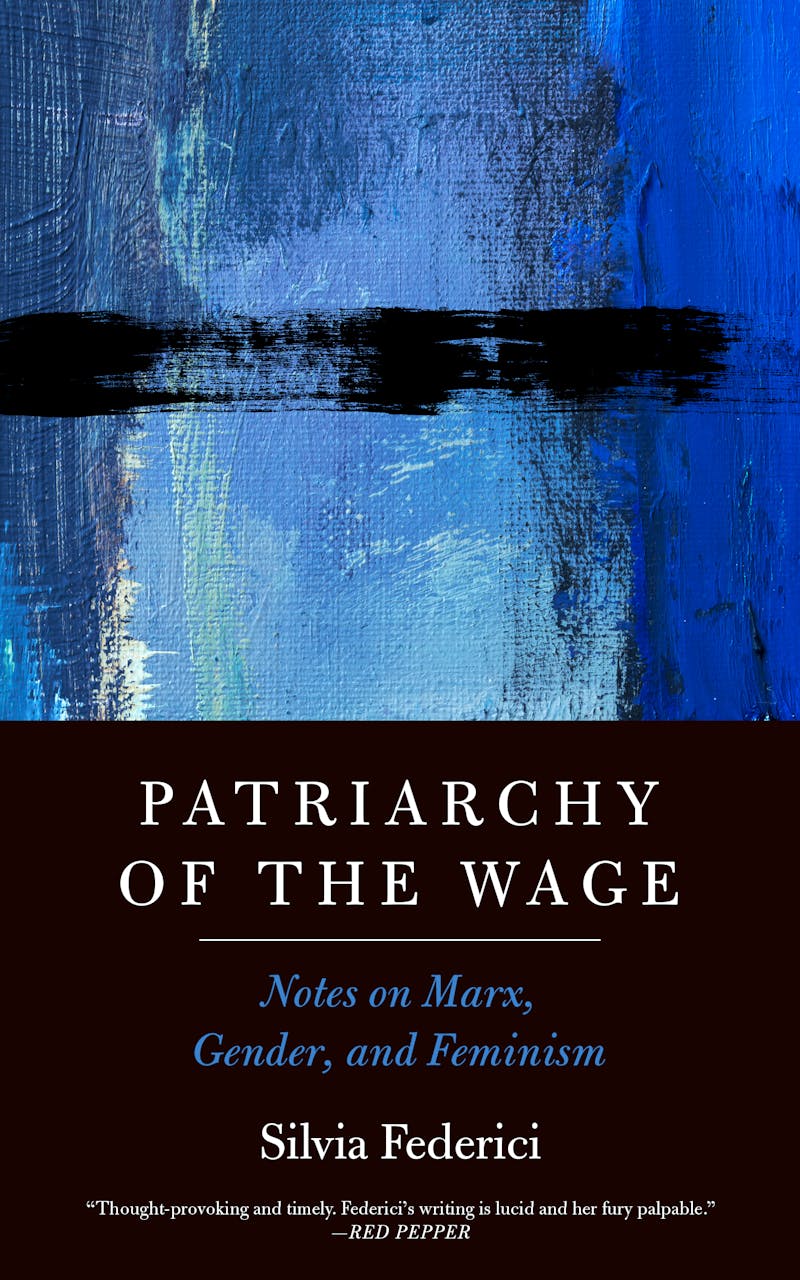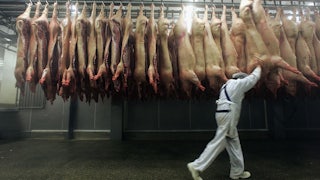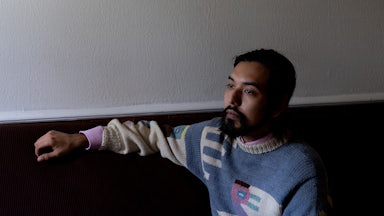It used to puzzle me that so many feminist books deal in literary criticism. Mary Wollstonecraft takes on Rousseau, Simone de Beauvoir attacks D.H. Lawrence, Shulamith Firestone spends several pages on a story by Herbert Gold, and Kate Millett pulls apart, well, everybody. Freud is a target, for blaming everything on women, as is Marx, for forgetting them. Couldn’t arguments for women’s liberation be mounted in themselves? Why perform the work of dissection when you could be proposing some more irresistible vision of the world?

When Silvia Federici came to the United States from Italy on a Fulbright scholarship in 1967, she was much more interested in what she could do than in how she could argue. In her research, she came across the work of Selma James, who had proposed a simple but startling idea at the third National Women’s Liberation Conference in Manchester, England: that women be paid for housework. “I was really inspired,” Federici remembers, and on a trip home to see family in 1972, she went to Padua to visit Mariarosa Dalla Costa, who had recently written a paper with James. The International Feminist Collective was formed at that meeting: They would mount a campaign to ask governments for wages for housework.
Federici helped set up the New York branch of the campaign (their first public action was to hand out flyers saying “No More Work for Free” in Prospect Park on May Day 1974) and wrote a pamphlet titled “Wages Against Housework.” Her version of the argument was subtle but boldly expressed: “We are seen as nagging bitches, not workers in struggle.” The work that goes on in the home—the cooking, the cleaning, the childcare, the elder care, the gardening, the shopping, the fixing, fetching, wiping, and carrying—wasn’t seen as work, but as something women did for love. This made it hard to refuse, or to share; it made what women did difficult to value, and even to see. But if a price was put on that work, wouldn’t that be the first step to changing it? And if we recognized that the work wasn’t in fact love, well, then “we might rediscover what is love.”
Although Federici speaks of capital and labor, class and wages, she doesn’t mention Marx by name in that first pamphlet, which has become a touchstone for feminists since the crash of 2008 and the Occupy movement. When she disentangled love from work, she laid the groundwork for arguments, recently mounted by Melissa Gira Grant and Juno Mac and Molly Smith, to recognize sex work as work. When she suggested care work was worth payment, she staked a claim for the type of collective care that abolition feminists such as Mariame Kaba hope will replace the carceral system. The coronavirus lockdowns also brought about a small revival of Federici’s ideas, as the work done by day-care centers, schools, and care homes as well as (in the homes of the upper middle class) cleaners and nannies fell back onto the family, and the simmering care crisis that Federici had identified in the 1970s reached a boiling point.
Over the last decade or so, PM Press has been reissuing 50 years of Federici’s work—collecting her housework writings in Revolution at Point Zero in 2012 and updating the idea in a new volume, Patriarchy of the Wage. Beyond the thrilling provocation of wages for housework, Federici has been addressing one of the most irritating gaps in Marx for feminists: the fact that he didn’t seem to notice women’s unpaid work, limiting his comments on it to footnotes. She uses Marx’s analysis of the relation between the worker and the boss in Capital and the Grundrisse to supply the gap, and leaves us with ideas that challenge the way things are, even in a world heating up and breaking down.
Born in Parma, Italy, in 1942, Federici grew up in a household not dissimilar to millions of others across the West. Her father went out to work—he was a professor of philosophy—and her mother stayed home. In a preface to Revolution at Point Zero, Federici remembers her mother “making bread, pasta, tomato sauce, pies, and liqueurs, and then knitting, sewing, mending, embroidering, and attending to her plants,” and realizes belatedly how painful it was for her mother to be “so often taken for granted,” dependent on Federici’s father “for every penny she spent.”
During her graduate studies in the early 1970s, Federici encountered a pamphlet by Mariarosa Dalla Costa that marked the start of her life as an active feminist. In “Women and the Subversion of the Community,” Dalla Costa argued that “women must completely discover their own possibilities—which are neither mending socks nor becoming captains of ocean-going ships.” Dalla Costa wanted a route to women’s liberation that didn’t look just like men’s. By the time Federici had reached the last page, she writes, “I had found my home, my tribe and my own self.” When Federici got in touch with Dalla Costa, she was just in time to contribute to the Wages for Housework campaign. She began organizing the New York committee with Nicole Cox in 1973, and it was her pamphlet “Wages Against Housework” that would become the most accessible and enduring formulation of the idea behind getting paid for doing dishes.
The campaign sparked furious exchanges in the left-wing journals of the time, and was misunderstood by everyone from liberal feminists to Marxists themselves. Some thought that women were just greedy: They were happy as they were, but wanted more money. Others thought that an idea dreamed up in Italy couldn’t hold in the United States, where more women worked outside the home. (In the 1980s, Angela Davis would suggest that more women joining the traditional workforce, and fighting for robust social services from that position, was a better way of tackling the problem.) Still more thought the love shown in the work of making a home was one of the few activities capitalism hadn’t tainted and should stand inviolate. And should the government pay for these wages? Why not businesses? Why not husbands? The New York wing of the Wages for Housework movement organized marches and teach-ins at laundromats and supermarkets. They held table-top sales where you could buy Wages for Housework pot holders. But Federici’s “militant” phase, as she has called it, ended in 1977 when the chapter crumbled.
Then came the arguing: Federici wanted to look back to the beginnings of capitalism in order to trace the ways women were exploited, excluded, and mystified out of economic power. In her efforts to understand these processes, Federici turned to literature, specifically the story from The Tempest of Caliban, the island native, and Sycorax, his mother, who had been exiled from Algiers for her witch’s ability to control the moon. Sycorax taught her son to appreciate and channel the power of the land and its waters. As queen, she raised him as the rightful heir to the isle that is, as Caliban tells two drunken courtiers who wash up on its shores, “full of noises, / Sounds, and sweet airs, that give delight and hurt not.” When Prospero arrives on the island, he seizes power, enslaving Caliban and abolishing his mother’s customs. In the transition from their government to his, Federici saw an analogy for how patriarchy established a stranglehold over society.
In her 2004 book, Caliban and the Witch: Women, the Body and Primitive Accumulation, she looks through the archives for real-life versions of Sycorax and Caliban, beginning in the Middle Ages. Federici tells us of Gostanza, a widow who was tried as a witch in San Miniato, Tuscany, in 1594. She lived in an all-female household—with a niece and two other widows—and worked as a healer, receiving people in her home but also traveling “to ‘mark’ an animal, visit a sick person, help people carry out a revenge.” She used oils, but also “devices apt to cure and protect by ‘sympathy’ or ‘contact.’” As Federici notes, she was “very popular, everyone would go to her to be cured, to have his or her fortune told, to find missing objects or to buy love potions.” Like Sycorax, she was punished for seeming to have too much power. Federici also writes of a number of young English settlers in seventeenth-century Virginia, who were executed for living among Native tribes. They had formed an alliance against the colonists, which Federici sees as similar to the alliance Caliban forms with the drunken courtiers against Prospero.
Federici even suggests you can glimpse what a Sycorax-ruled island might have looked like by examining the way women worked under feudalism. Female serfs worked the fields as well as cooking, spinning, and keeping an herb garden at home, drawing no great division between work done inside and outside. And as women washed, harvested, and tended animals collectively, their work became a source of “intense female sociality and solidarity” that allowed them “to stand up to men.”
In Federici’s reading, witch hunts were a way of limiting female freedom, and pushing women back into the home. Witches didn’t fly on broomsticks; they earned their own living, slept with whom they wanted to, and cared for the vulnerable. It took several hundred years of terror, persecution, and torture to stop women living independently and cooperatively, and even then the efforts didn’t fully succeed. Ever harsher penalties for infanticide, contraception, abortion, and midwifery, up to execution, were needed to make it clear that women’s allotted (and safest) role in society was to bear and rear children.
Caliban and the Witch was published by Autonomedia, a tiny left radical press run as a collective, but has grown in influence and was republished as a Penguin Modern Classic last year. It’s an attractive argument in much the same way that Wages for Housework is: It takes an aspect of women’s lived history and re-situates it as a source of power. A single woman living in a city apartment building might feel less lonely if she saw herself as part of a tradition of resistance to capitalism that began in the sixteenth century, just as a frustrated housewife in Brooklyn 50 years ago could find a movement in which her work was finally valued.
After a long period of neglect, Federici’s ideas were in circulation again, and her next book, Revolution at Point Zero, reprinted and repopularized her writings about housework, care, and social reproduction. By the 2010s, a whole generation had come of age expecting to build careers outside the home, largely thanks to the advances of the 1970s. But they hadn’t been able to shed their work inside it. As Arlie Russell Hochschild identified as early as 1989 in her book The Second Shift, many women were working a second job when their nine-to-five was over: doing the full-time work of taking care of their homes and families in the evenings and early mornings, on top of their paid work. Housework hadn’t gone away: In many ways, it had become even more important.
The essays in this new volume, Patriarchy of the Wage, written from 1975 to 2020, return to the premise of Wages for Housework and see what it can offer feminism today. Federici goes right back to her first pamphlet, and tries to explain again why she uses wages to show the value of housework. A wage is more than a sum of money every month; it’s a way of appeasing the worker just enough so that the boss can keep the profit. One of Marx’s biggest questions is, what does waged labor hide? Wages hide things like the coal miners’ commute George Orwell describes in The Road to Wigan Pier: To get to the coalface takes at least an hour a day, half-bent in the dust-black air, and isn’t paid. The miner’s work starts, as far as his employer is concerned, when he is stood in front of the glittering black wall of coal with his pick. That hidden hellish commute, and all the other things a worker does in order to be ready to claim his wages, are part of what eventually become the boss’s profit.
What else do wages hide? Federici notices that a father’s wages hide a mother’s work. The mid-century ideal was the “family wage” with its expectation that a male breadwinner should earn enough to keep a wife and children, who are concealed from capital. What would happen, Federici asks, if you didn’t hide that work? In asking the government for a paycheck, as well as for more social services and free social services, Federici and her peers were asking society at large to see them, to recognize their work, to negotiate. They were questioning what wages are for, who they reward, and how they operate. As you ask these questions, you find that all wages start to look strange, the premise they’re based on arbitrary and confusing.
“The struggle for the wage is at the same time a struggle against the wage, for the power it expresses and against the capitalist relation it embodies,” Federici writes in the opening essay to this volume, a 1975 piece titled “Counterplanning From the Kitchen.” When people who are not paid for their work start asking for pay, they’re often told there simply isn’t enough money to meet their demands. What becomes clear is that neither private businesses nor public entities can afford to pay for all the unpaid work done in society. If the system operated logically, it could not stand. The demand for a wage reveals, too, that no one’s wages are adequate for the work they do, that no one’s life should be sacrificed to work. “We have always belonged to capital every moment of our lives,” Federici writes in italics, “and it is time that we make capital pay for every moment of it.”
Whereas early essays such as “Wages Against Housework” and “Counterplanning From the Kitchen” were combatively purposeful, later ones collected in Patriarchy of the Wage are measured, almost dry, in tone. With their footnote-deep intimacy with Capital and the Grundrisse, they not only borrow from Marx but constantly return to his silence on domestic work. There are historical reasons Marx didn’t write about housework (not least that, in the mid-nineteenth century, plenty of women and children worked in factories, too), and there are political reasons (Marx had to start somewhere), but it plays on Federici’s mind. Why wasn’t Marx interested in the processes by which workers were born and brought up? “Our work produces the most precious product on the capitalist market: labor power,” Federici observes. Marx chose to focus on industrial labor and thought that mankind should dominate the earth. Federici tracks some of the ways Marx’s thought developed later in life, and wonders if, in time, he “may have also understood the importance of feminism, which he often dismissed as a struggle for bourgeois rights.”
I sometimes wondered why Federici seemed so disappointed in Marx for being, though a genius, a nineteenth-century man who was married but slept with his housekeeper. Federici’s inquiries lead her to the limits of Marx’s thought, and those limits in turn become a spur to her own ideas. Marx, for instance, wanted mechanization and other efficiencies to free the worker for afternoons fishing at the lake and evenings debating at dinner, but Federici counters that the work she’s interested in cannot always be done by machines. “How can we mechanize washing, cuddling, consoling, dressing and feeding a child, providing sexual services, or assisting those who are ill and the elderly and not self-sufficient?”
It is not as if we haven’t tried mechanizing care. During the pandemic, when care workers couldn’t run dining clubs for older adults, New York State’s Office for the Aging gave robot cats and dogs to their charges. Although the owners often forgot their pets were electronic, their loneliness persisted: Katie Engelhart wrote in The New Yorker of the way an interviewee would keep her on Zoom at the end of their conversation, asking her questions about the weather where she was.
Instead of lovebots, nursebots, and electric cats, Federici points to the potential of experiments in collective childcare; to efforts to expand the nuclear family, such as alloparenting, in which friends and neighbors share the work of running a household; and to the creation of “reproductive commons,” which can be seen in fisheries in Maine where lobster fishers have agreed on rules to protect breeding waters at informal, local, state, and federal levels and thereby made their fisheries some of the most sustainable in the world. One of Federici’s examples of commoning is the establishment of collectively run urban gardens across the United States, which have become, over time, “places where people come together not just to work the land, but to play cards, hold weddings, have baby showers or birthday parties.” You can walk past the edge of Marx’s thought and into a tomato patch, where the vines are for everybody. Commoning doesn’t have to be utopian and out of reach: Federici most often detects it in grassroots responses to injustice. From Cambodia to Senegal, women set up “money commons,” where they gave small loans on trust, in response to the shaming tactics of the World Bank; when inflation was out of control during the 1980s in Chile, and households couldn’t afford to shop and cook singly, they turned to communal kitchens.
Wollstonecraft, De Beauvoir, Firestone, Millett, and Federici—all used arguments with their intellectual fathers to work out what they didn’t want their worlds to look like. But as much as feminism was sharpened through these literary-critical encounters, it has always drawn strength from the life experience of its mothers. Federici sees her own work renewing and revitalizing Marx as the making good of her mother’s invisible work. “What often saves me when I cannot protect myself,” she wrote in June 2011, “is my commitment to protect her work and myself as the child to whom it was dedicated.” It is this that makes emotional labor, care work, social reproduction, whatever you like to call it, different from other work. It is an investment in a person for its own sake, a debt that can be considered paid not at clocking-off but on returning the investment in the same spirit. It is our first recognition that we must rely on one another to get through life, and our first intimation of how the relying and the getting through might be done.
This article appeared in the March 2022 print edition with the headline “All Work and No Pay.”






